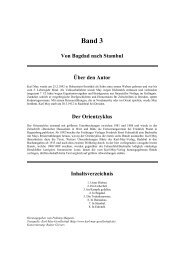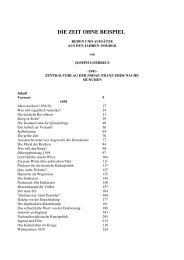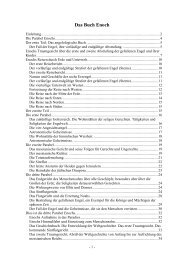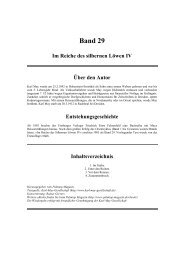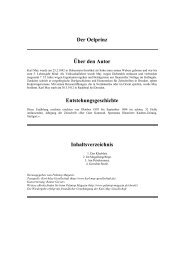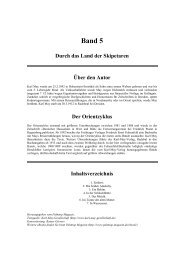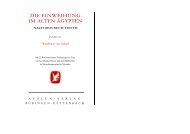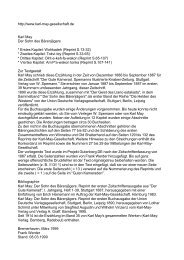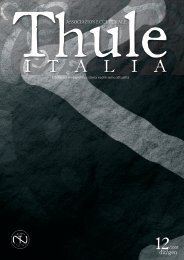Thule Italia feb2006.indd - Thule-italia.net
Thule Italia feb2006.indd - Thule-italia.net
Thule Italia feb2006.indd - Thule-italia.net
Create successful ePaper yourself
Turn your PDF publications into a flip-book with our unique Google optimized e-Paper software.
RELATIONS BETWEEN<br />
THE UNITED STATES<br />
AND THE GERMAN III REICH (1929-1942)<br />
In the USA, the 1929’s crisis has deeply shaken the<br />
economically prosperous twenties.<br />
During these years, Germany was one of the most sensitive<br />
countries to the American industrial systems. In fact, the<br />
IgFarben, founded on 1923, became in the short term of<br />
15 years, the most powerful industry of the country which<br />
controlled four fifths of its (chemical) sector, basing its<br />
production on the American model. 1<br />
On the other hand, the most important industries of<br />
Germany, like the Vereinigte Stahlwerke (steel sector),<br />
IgFarben and AEG (electrical sector) have been created<br />
with a $ 170’s million loan by the National City Bank,<br />
Chase Manhattan Bank, Morgan Bank, Kuhn & Loeb Bank,<br />
Rockefeller ‘s Standard Oil, General Motors, Paul Warburg.<br />
As the writer Antony Sutton in his book Wall Street and<br />
the rise of Hitler 2 wrote “There were over 2,000 cartel<br />
agreements between I. G. and foreign firms — including<br />
Standard Oil of New Jersey, DuPont, Alcoa, Dow Chemical,<br />
and others in the United States”.<br />
However, after the outbreak of the crisis of 1929, US<br />
Congress adopted many protectionist policies, like the<br />
Fordney-McCumber Act that rose American custom<br />
barriers from 27% to 38.5%.<br />
But, Protectionism drastically worsened trade with the<br />
European countries too, obstructing their own profit<br />
necessary to payments, in particular, Germany had been<br />
forced to stop war debts’ payment to the USA.<br />
An American banker, Charles G. Dawes, created a special<br />
plan for Germany to make possible its reparations. He<br />
suggested an American loan of $ 200 million to stabilize<br />
German economy and to resume reparation payments.<br />
With it, Germany has been able to paid part of the sum<br />
which was further reduced through the Owen D. Young’s<br />
plan.<br />
It was after the stock market crash that Herbert Hoover<br />
agreed to a suspension of payment of reparations and<br />
war debts from the 1 st of July 1931 to 30 June 1932. And<br />
it was at the Lausanne Conference that the issue was<br />
definitely closed. 3<br />
At the basis, a real lack of communication and of a<br />
common crisis’s solution have negatively influenced<br />
transatlantic relations, characterizing at the same time<br />
a growing Isolationism in the USA and a major dubious<br />
attitude in Europe towards it.<br />
The obvious consequence has been the autarchic policies<br />
and trade wars. In fact, the global mo<strong>net</strong>ary instability<br />
emphasized trade tensions with many trusts’ rivalries, for<br />
example for raw materials and oil reserves.<br />
Those difficulties have provoked many unilateral financial<br />
solutions: in 1931, Great Britain (GB) devaluated Pound by<br />
25%, in 1934, the USA devaluated Dollar by 40%. 4<br />
Freya<br />
In the USA, American nationalism rose causing also a new<br />
series of laws which blocked European immigration to<br />
the USA to protect life’s level of American workers and to<br />
guaranty the alienation of Slavs and also of communists<br />
immigrants.<br />
In Birken’s opinion, Hitler admired 18th- and 19thcentury<br />
America, especially its restrictions on non-White<br />
immigration and pro-White racial policies. 5<br />
But the immigration restriction regarded also European<br />
people and that kind of policy contributed to a grievous<br />
growth in the unemployment rate in Europe.<br />
In Germany, it started just in 1928 with an agricultural<br />
crisis, and then for an industrial-financial one. In fact,<br />
during the twenties, American investments came to an<br />
end in the attempt to face the Wall Street collapse.<br />
The German crisis has been one of the most wide in<br />
Europe, in particular, the economic activity deeply broke<br />
down reaching levels similar to the American ones, for<br />
example in mines’ incomes as steel -64% and coal -35.9%<br />
compared to the American data for the same products -<br />
75.8% and -40.9%. 6<br />
In 1932, unemployment in Germany rose to 6 millions<br />
and 39 thousands (compared to the 10 millions and 477<br />
thousands of the USA) and constituted the 20% of the<br />
total labour force of the country.<br />
The unemployment rate crisis pushed German Nationalists<br />
in a favourable position in the political life of the country.<br />
In fact, the Nazi Party moved from 2.6% in 1928 to 37.3%<br />
in 1932 and 43.9% in 1933. 7<br />
In 1933, the new Chancellor Adolf Hitler tackled<br />
unemployment elaborating an economic plan minutely<br />
exposed in his Mein kampf.<br />
Hitler’s first plan was the speeding up of public jobs as<br />
motorways and rearmament. Thanks to these policies,<br />
the number of unemployed decreased from 2.657.000 in<br />
1934, 2.151.000 in 1935 and 429.000 in 1938. Especially<br />
the weapons’ industry helped the State against its<br />
economic collapse. In fact, the production value rose<br />
from 2.6 millions marks in 1932 to 41.5 millions marks in<br />
1938. Germany protected its economy by substituting<br />
raw material imports with those artificially produced in<br />
Germany itself, as rubber, petrol and some other textile<br />
industrial products. 8<br />
Therefore, the German treasurer Hjalmar Schacht was able<br />
to conduct State financial recovery by isolating the Mark<br />
in comparison to the other currencies. In fact, after 1929’s<br />
crack, the collapse of foreign capitals and of the banking<br />
groups caused in Germany a financial disequilibrium<br />
with a clean rise of the inflation rate and a devaluation<br />
of Mark. 9<br />
The problem of unemployment and popular resentment<br />
1 GIUSEPPE MAMMARELLA,<br />
Destini incrociati- Europa<br />
e Stati Uniti nel XX secolo,<br />
Laterza, Bari, 2000, 66.<br />
2 ANTONY SUTTON, Wall<br />
Street and the rise of Hitler,<br />
available online:<br />
http://reformed-theology.<br />
org/html/books/wall_<br />
street/index.html , last<br />
accessed 2005-11-20.<br />
3 ENNIO DI NOLFO,<br />
Storia delle relazioni<br />
internazionali 1918-1999,<br />
Laterza, Bari, 2003, pages<br />
37-49.<br />
4 GIUSEPPE MAMMARELLA,<br />
Destini incrociati- Europa<br />
e Stati Uniti nel XX secolo,<br />
Laterza, Bari, 2000, 68.<br />
5 LAWRENCE BIRKEN,<br />
Hitler as “Enlightenment<br />
Intellectual”: The Enduring<br />
Allure of Hitlerism, from<br />
The Journal<br />
of Historical Review, Vol.<br />
16, No. 5, Sept.- Oct. 1997,<br />
pages 34-37.<br />
6 GIUSEPPE MAMMARELLA,<br />
Destini incrociati- Europa<br />
e Stati Uniti nel XX secolo,<br />
Laterza, Bari, 2000, 72.<br />
7 Ibid, 72.<br />
8 Ibid, 73.<br />
9 Ibid, 75.<br />
10 RODERICK STACKELBERG<br />
, Hitler’s Germany- Origins,<br />
Interpretations, Legacies,<br />
Routledge, London, 1999,<br />
101.<br />
11 FREDERICK W. MARKS,<br />
Six between Roosevelt and<br />
Hitler: America’s Role in<br />
the Appeasement of Nazi<br />
Germany,<br />
The Historical Journal,<br />
Vol. 28, No. 4, Dec. 1985,<br />
Cambridge University<br />
Press, 971.<br />
12 GIUSEPPE<br />
MAMMARELLA, Destini<br />
incrociati- Europa e Stati<br />
Uniti nel XX secolo, Laterza,<br />
Bari, 2000, 88.<br />
13 MASSIMO TEODORI,<br />
Storia degli Stati Uniti e il<br />
sistema politico americano,<br />
Newton & Compton, Roma,<br />
1996, 65.<br />
14 DUBAIL RENÉ,<br />
L’ordinamento economico<br />
nazionalsocialista,<br />
All’insegna del Veltro Ed.,<br />
Parma, 1991, 93.<br />
15 DUBAIL RENÉ,<br />
L’ordinamento economico<br />
nazionalsocialista,<br />
All’insegna del Veltro Ed.,<br />
Parma, 1991, 217.<br />
16 Ibid, 82.<br />
17 Ibid, 93.<br />
18 RODERICK STACKELBERG<br />
, Hitler’s Germany- Origins,<br />
Interpretations, Legacies,<br />
Routledge, London, 1999, 86.<br />
19 The chief of the Labour<br />
Front who managed the<br />
Nazi party organization.<br />
20 From a confidential letter<br />
send by Dodd to Roosevelt<br />
in November 27,1933.<br />
Document available at<br />
“The Roosevelt<br />
Presidential Library” online:<br />
http://www.fdrlibrary.<br />
marist.edu/psf/box32/<br />
t299c01.html , last accessed:<br />
2005-11-16.<br />
in lingua<br />
which derived from the historical memory, as the after-war<br />
measures so hard for the German people, have absolutely<br />
contributed to root German Nationalism.<br />
According to that, in his appeal to the German people, on<br />
February 1, 1933, Hitler sounded a conservative revivalist<br />
theme:<br />
“The national government sees as its first and foremost task<br />
the restoration of the unity of spirit and will of our people.<br />
It will preserve and protect the fundamentals on which<br />
the strength of our nation rests. It will preserve and protect<br />
Christianity, which is the basis of our system of morality, and<br />
the family, which is the germination cell of the body of the<br />
people and the state.” 10<br />
These years were characterized by political instabilities<br />
in Europe, however no European country effectively<br />
opposed Hitler’s growing power in Germany nor against<br />
his rearmament policy in peace time, neither did the US<br />
react.<br />
On the contrary, the German industry, based on steel,<br />
electrical and chemical sectors, and therefore, the<br />
Vereinigte Stahlwerke, the IgFarben and the AEG<br />
structures which have been created with American bank’s<br />
support, was based exactly on war production.<br />
According to Frederick W. Marks, too, President Roosevelt<br />
gave his positive opinion about the new German<br />
Chancellor: “When Reichsbank president Hjalmar Schacht<br />
came to Washington in May, Roosevelt reportedly told<br />
him that Hitler was the right man for Germany and that<br />
no one else could inspire such confidence.” 11<br />
American Protectionism, its rising duties, the devaluation<br />
of the dollar, American nationalism and the closer<br />
immigration laws rose the American sense of Isolationism.<br />
But, between 1936 and 1940, American investments in<br />
Germany also rose to 40%. 12<br />
That explains that economically the relations went on and<br />
the US and Germany took similar ways to exit the disastrous<br />
consequences they were in by pursuing national interests’<br />
attainment as Protectionism and Isolationism or autarchic<br />
measures.<br />
The USA based their economy on the “New Deal” system,<br />
inspired on John Maynard Keynes’s principles, which has<br />
the effect to rise the State deficit, to increase investments<br />
and to avoid the consumptions’ cut (deficit spending) 13 . It<br />
was a specific policy to contrast the economic Depression<br />
coupled by the rising of consumer’s purchasing power<br />
which would have remedied at the surplus production 14 .<br />
The solution is often considered the antecedent of<br />
Liberalism, the typical American economic current which<br />
is supported by free trade, too, because of its tendency to<br />
be devoid of State control.<br />
Germany, unlike the US, followed a community political<br />
philosophy which could be defined as “agreed, concerted<br />
or controlled” 15 . According to that, the German State would<br />
not have exclusively managed economy but it would have<br />
given targets and means to predisposed bodies charged<br />
to pursue them 16 , like in the subsidiary systems. German<br />
target was the throwing again of production factors 17<br />
rather than the distribution of goods like in the USA was.<br />
Therefore, Germany and the US lead different economical<br />
ways to face the crisis’s consequences.<br />
Even if both countries economically “protected” themselves<br />
with similar solutions as the hard industry increase,<br />
their different philosophies would have spaced out the<br />
countries worsening in that way their coexistence.<br />
German nationalism took expression in the Nazi Party<br />
which soon would have become the most important<br />
and active party of the State, identifying itself with the<br />
German state.<br />
With the advent of Hitler, the Nazi Party became the<br />
country’s leading right-wing party. In 1933, Hitler invited<br />
the German National People’s Party (DNVP) to join his<br />
coalition government and so “de facto” cancelling it.<br />
From that moment, the home policy of the country came<br />
to be marked by a stronger increase in value of German<br />
goods and properties, as against “the Jewish companies<br />
which speculate in land” 18 .<br />
The fuehrer represented the Nazi party with his strong<br />
personality and through the no-compromise goals he<br />
auspicated. They would have rehabilitated Germany in<br />
the international context principally with the revision of<br />
the Versailles settlement.<br />
The German consensus to Hitler and the Nazi party,<br />
from early 30s, could confirm the idea that the Germans<br />
were not totally and absolutely contrary to the extreme<br />
nationalists.<br />
The high hierarchy of the German organizations deeply<br />
admired Hitler’s personality and they tended to recognize<br />
him as a genius inspired, as recalled by Doctor Ley 19 in<br />
an interview made by the American writer Lothrop<br />
Stoddard.<br />
The American ambassador to Berlin, William E. Dodd, often<br />
criticized the German Nationalists and as consequence<br />
of that, the rising of the Nazi Party. Moreover, he openly<br />
reported to Washington his preoccupations and<br />
suspicions.<br />
In November 27, 1933, Dodd wrote a confidential letter to<br />
Roosevelt where he affirmed that Hitler was a menacing<br />
presence and he was supported by unemployed people:<br />
“He rose to power by organizing elements in Germany which<br />
were partly unemployed and wholly indignant because<br />
Germany had not won the great war. His devices are the<br />
devices which men set up in ancient Rome, namely, his flag



